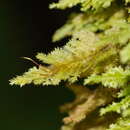Comprehensive Description
provided by Smithsonian Contributions to Botany
Lopidium concinnum
Lopidium concinnum (Hook.) Wils. in Hook. f., Fl. Nov. Zel. 2:119, 1954.
Leskea concinna Hook., Musci Exot. 1:34, 1818. [Original material: Dusky Bay, New Zealand, coll. D. Menzies, 1791.]
Lopidium pallens Hook. f. & Wils., Fl. Nov. Zel. 2:119, 1854. [Original material: North & Middle Islands, New Zealand: Auckland & Waikehi, coll. Sinclair; Bay of Islands, coll. J. D. Hooker, 1839–1843; Bligh’s Sound, Hutt Valley, Milford Sound, Wellington and Ship Cove, coll. Lyall. Also credited to Tasmania, South America, Chiloe.]
Hypopterygium pallens (Hook. f. & Wils.) Mitt., Kew J. Bot. 8:265, 1856.
Hypopterygium flexisetum Hampe in Lorentz, Bot. Zeit. 24: 187, 1866, nom. nud.
Hypopterygium plumarium Mitt., J. Linn. Soc., Bot. 12:329, 1869. [Original material: Fazendado do Lageado, near Curitiba, 2000 ft, Paraná, Brasil, coll. Weir n. 1; Chiloe Isl., Chile, coll. Lobb; Auckland Isl., coll. J. D. Hooker, 1839–1843.]
Lopidium plumarium (Mitt.) Hampe, Vid. Medd. Naturh. For. Kjoebenh. ser. 4, 1:162, 1879.
Lopidium aristatulum C. Müll. in Ule, Hedwigia 38(Beibl. 1): 58, 1899, nom. nud.
Hypopterygium araucarieti C. Müll. in Kindberg, Hedwigia 40:281, 1901, nom. nud. in syn.
Lopidium araucarieti Fleisch., Hedwigia 63:213, 1922, nom. nud.
Plants to 10 cm tall, stipe 1–2 cm long, stipes bare or slightly radiculose below. Lowest stipe leaves very broadly ovate, ca. 0.7 mm long, 1.0 mm broad, very short and broadly acuminate; ecostate; median cells rhomboid, ca. 25 μm wide, to 40 μm long; cells toward border more quadrate, ca. 15 μm in diameter. Upper stipe leaves and lower stem leaves of frond ovate-lanceolate, ca. 1.0–1.5 mm long, 0.6–0.9 mm wide; margin weaker; basal cells oval, 25–30 μm long, strongly porose. Upper stem and branch leaves narrowly oblong, to 1.5 mm long, 0.7 mm wide; ventral leaves to 1.0 mm by 0.4 mm. All upper leaves with tips abruptly narrowed to short, stout apiculus; margins with 1–2 rows of narrow cells often failing near tip, distal margin sharply serrate; costa slender, ca. 25 μm wide near base; lamina cells mostly rounded with thickened angles, 7–12 μm in diameter. Autoicous. Setae 2.5–9.0 mm long, nearly smooth or slightly roughened. Capsule urn 1.5–2.0 mm long; spores 12–14 μm in diameter, smooth.
MAS A TIERRA: Ridge between Q. Piedra Agujereada and Q. Laura, 650 m, Sk. 332.
The species is known from Brazil, Argentina, Chile, Juan Fernandez, New Zealand, Tasmania, Australia, and the Auckland Islands. Some of the confusion regarding the history of the species is discussed by Dixon (1913–1929).
- bibliographic citation
- Robinson, Harold E. 1975. "The mosses of Juan Fernandez Islands." Smithsonian Contributions to Botany. 1-88. https://doi.org/10.5479/si.0081024X.27

